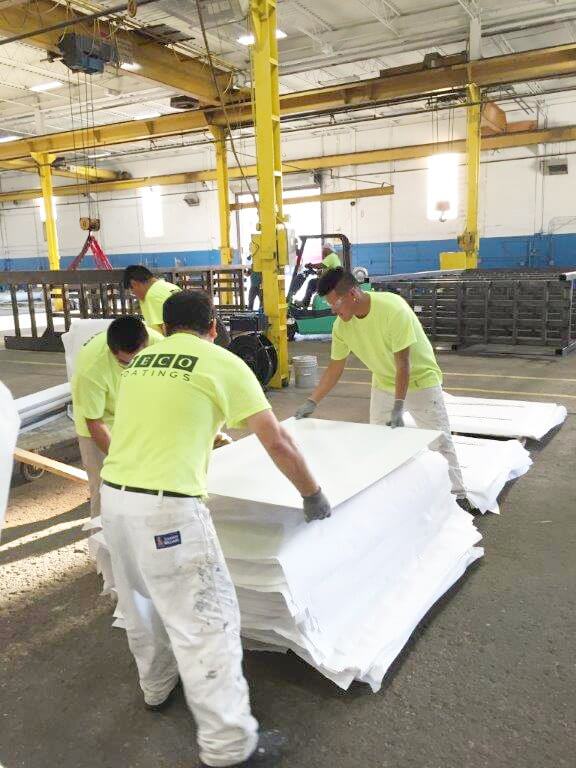
Specialty coatings are my specialty. They are what I have done, day in and day out, for almost two decades.
Our company hyper focuses on a niche market of industrial specialty coatings as both a state and federally approved contractor. We even have an on-site testing facility to test new methods and new products that come onto the market. So you could say we are somewhat scientists at what we do.
As Project Engineer at DECO coatings, it is my daily job to determine some key things relevant to each of our coating projects…
1. What is the intended purpose for the coating?
2. What is the environmental exposure in which the coating will be placed?
3. What is the delivery schedule?
These answers mostly determine what type of coating we will use. Which coatings are best for industrial use? Here’s a hint…most of the time we avoid using powder coatings. Not that powder coatings are bad! They have their place in the world. However, they are very often misused, causing coating failure and a large expense to the customer.
There are two main types of coatings: liquid and powder. Traditionally, people know about powder coatings and tend to use those because they are familiar with them. But if you are going to hire a company to do such a large and important job, there a few things you should know about coatings so you don’t make a huge and costly mistake.
Class is in session! (This should only take about 4 minutes of your time, and trust me it’s worth it if you are planning on having any sort of professional coating job done.)
The first thing you should know is that the main use for liquid coatings are for industrial use. So you have an industrial job, most likely liquid coatings are what you should be using.

Powder coatings is an electrostatic dry finishing process that must be applied with specialized electrostatic spray equipment. It has been used in North America since the 1960’s, so it has been around for a while.
What everyday products should be powder coated? Toys, bicycles, fire extinguishers, antennas, etc.
Here’s the problem with powder coatings:
- There is NO brush-and-roll option for application
- Field touch up is difficult at best
- Very limited color palette to choose from
- Slow lead times due to production process (production lines must be changed over for each individual color)
- They fail to rival the lasting, durable characteristic of a proven liquid coating
- Their benefits of a glossy smooth finish for manufactured items are usually not intended for industrial needs
- Powder penetration is limited in some surface areas
- They are required to be baked in an oven for curing (this means an extra step, more time, and need for available ovens that are specialized for such large items)
This video demonstrates the ease of removal of an existing powder coating
The steel hand rail is commonly used in a commercial or industrial environment
Notice how the powder coating is easily removed and shows little or no resistance to an outside force testing its limited property for adhesion.
“It’s All About Liquid Coatings!”
Liquid coatings form a special sort of “skin” that protects surfaces from UV/solar damage, oxidation, impact damage, and everyday wear and tear. They have an incredible track record for reducing corrosion and extending the life of the asset in industrial environments. Some liquid coated things you may recognize are football stadium lights, the Eifel tower, sports arenas, and bridge trestles.
What makes liquid coatings so special? Glad you asked.

- Waste WaterTreatment Plants use them as protective coatings
- Coatings must be resistant to chemicals used in treating waste water as well as corrosive Hydrogen Sulfide (a chemical created by waste water)
- They are safe for Clean Water needs
- Liquid coatings are safe for water to run through it and still be safe drink)
- Liquid coatings are Chemical Resistant
- For jobs needing chemical resistant coatings, the coating must have High Build capabilities (that means it can be put on in multiple coats)
- Liquid coatings are corrosion resistant with High Build capabilities
- Can be used in conjunction with zinc based coatings (powder cannot do this)

- They are UV Resistant
- Years of color & gloss retention as well as nearly limitless aesthetic color option
- Low VOC products are available
- This allows some liquid coating products into regulated areas
- Ambient Temperature Curing
- NO OVEN BAKE required! (Powder coatings need to be heated in an oven)
- FAST Turn Around
- Easy to switch colors in a production environment
- Cost savings with color coding
- Liquid coatings come in thousands of color options and custom formulas, while powder is limited on color choices
So that’s about the full rundown on powder coatings vs. liquid coatings. Hopefully you go forward, confident in your choice of coatings for your project. If not, then you have some great trivia for the next dinner party you attend.
How DECO works with liquid coatings

“Experts in staging climate controlled conditions on site”
DECO has a 50,000 sq ft plant operation of controlled conditions for application to new, and for replacement of process pipes, metals, structural steel, storage tanks, heavy duty machinery, safety rails & metals, racks, gates, bolts, plates, support metals, and more.
- Field Application
- Spray Method is used (when conditions allow)
- Brush & Roll Method is used
- Is not limited by length or size of pieces to be coated
